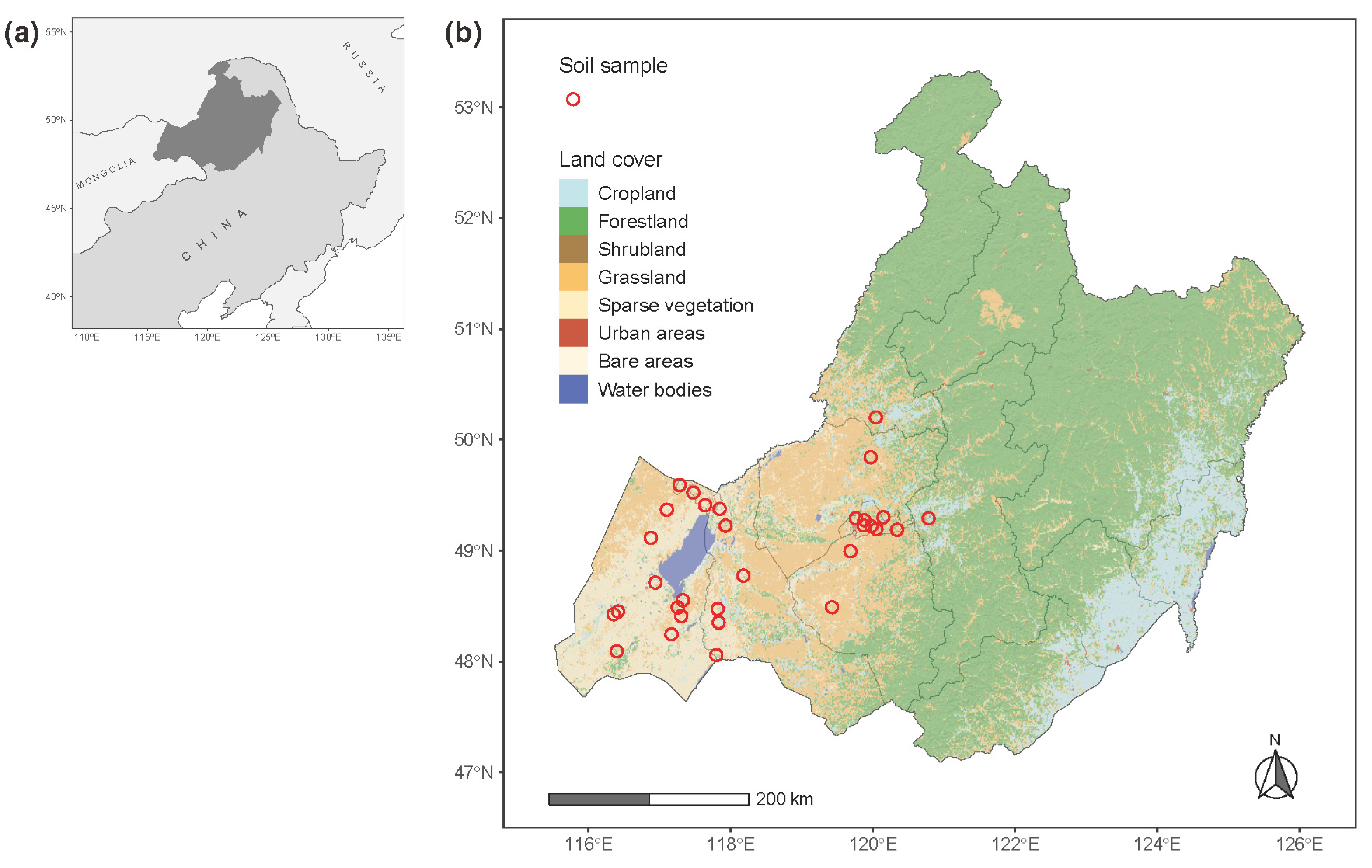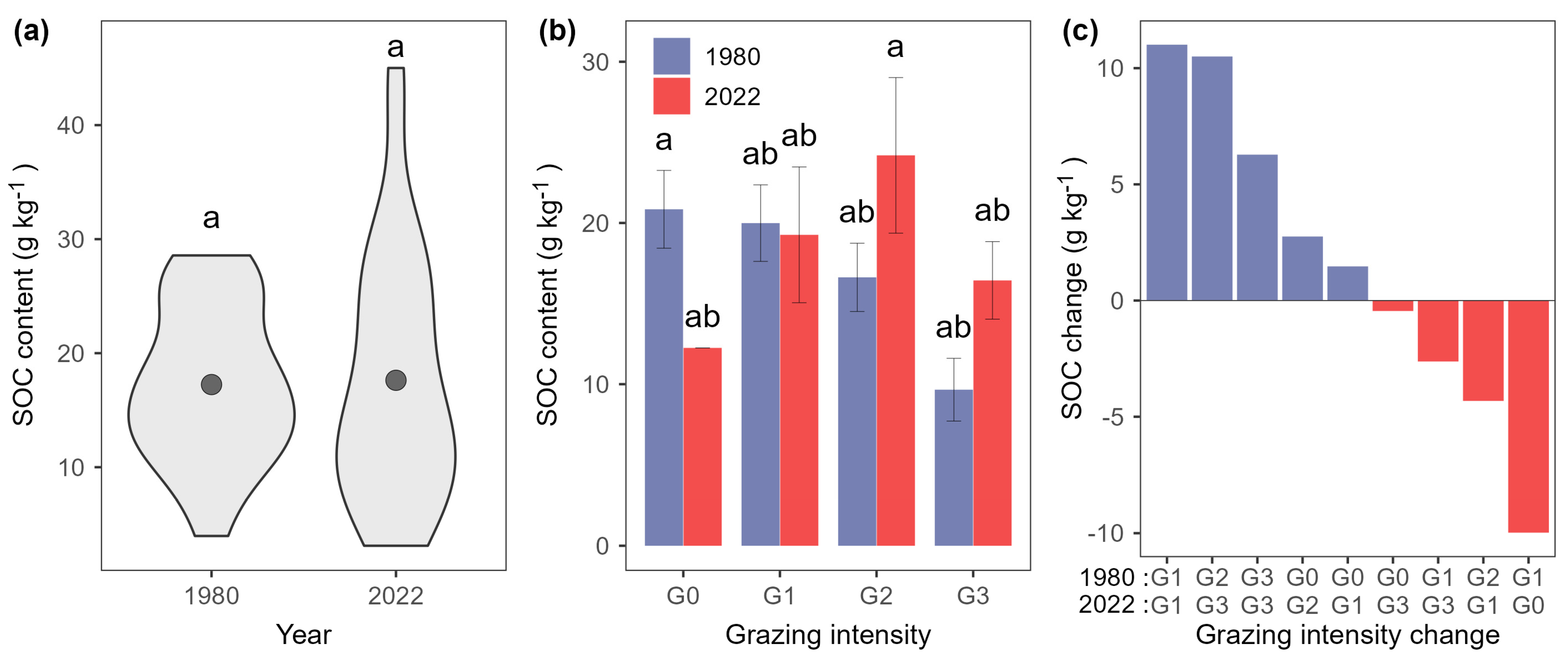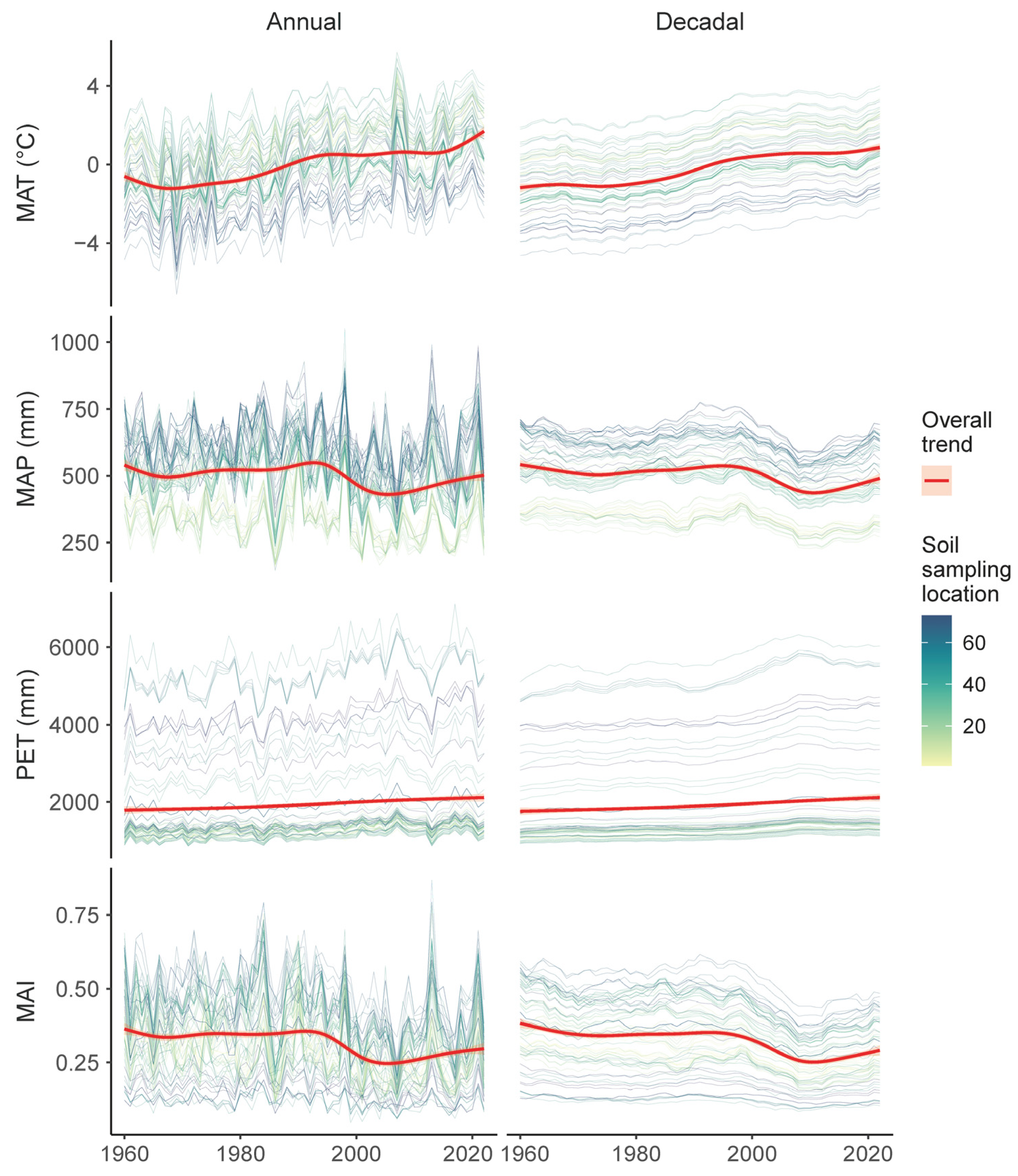Fourfold Increase in Climate Contributions to Grassland Soil Organic Carbon Variabilities and Its Policy Implications
Abstract
:1. Introduction
2. Materials and Methods
2.1. Study Area
2.2. Soil Sampling
2.3. SOC Covariates
2.4. Model Development
2.5. Relative Importance
3. Results
3.1. SOC Change
3.2. Climate Change
3.3. SOC Determinants
3.4. SOC Models
3.5. Relative Importance
4. Discussion
4.1. Northern Temperate Grasslands in China Are C-Neutral
4.2. Climate, Landscape, and Management Variables Predict Grassland SOC
4.3. Climate-Attributable SOC Variabilities Increased Fourfold over 40 Years
4.4. Policy and Management Implications
5. Conclusions
Supplementary Materials
Author Contributions
Funding
Data Availability Statement
Conflicts of Interest
References
- Lal, R. Soil carbon sequestration impacts on global climate change and food security. Science 2004, 304, 1623–1627. [Google Scholar] [CrossRef] [PubMed]
- Gruba, P.; Socha, J. Exploring the effects of dominant forest tree species, soil texture, altitude, and pH-H2O on soil carbon stocks using generalized additive models. For. Ecol. Manag. 2019, 447, 105–114. [Google Scholar] [CrossRef]
- Beillouin, D.; Corbeels, M.; Demenois, J.; Berre, D.; Boyer, A.; Fallot, A.; Feder, F.; Cardinael, R. A global meta-analysis of soil organic carbon in the Anthropocene. Nat. Commun. 2023, 14, 3700. [Google Scholar] [CrossRef] [PubMed]
- Breulmann, M.; Boettger, T.; Buscot, F.; Gruendling, R.; Schulz, E. Carbon storage potential in size-density fractions from semi-natural grassland ecosystems with different productivities over varying soil depths. Sci. Total Environ. 2016, 545–546, 30–39. [Google Scholar] [CrossRef] [PubMed]
- IPCC. Land Use, Land-Use Change, and Forestry; Watson, R.T., Noble, I.R., Bolin, B., Ravindranath, N.H., Verardo, D.J., Dokken, D.J., Eds.; Cambridge University Press: Cambridge, UK, 2000; p. 377. [Google Scholar]
- Ye, L. Editorial: Enhancing food production system resilience for food security facing a changing environment. Front. Sustain. Food Syst. 2023, 7, 1204098. [Google Scholar] [CrossRef]
- Ye, L.-M.; Malingreau, J.-P.; Tang, H.-J.; Van Ranst, E. The breakfast imperative: The changing context of global food security. J. Integr. Agric. 2016, 15, 1179–1185. [Google Scholar] [CrossRef]
- Xu, L.; Yu, G.; He, N. Increased soil organic carbon storage in Chinese terrestrial ecosystems from the 1980s to the 2010s. J. Geogr. Sci. 2019, 29, 49–66. [Google Scholar] [CrossRef]
- Han, D.; Wiesmeier, M.; Conant, R.T.; Kuhnel, A.; Sun, Z.; Kogel-Knabner, I.; Hou, R.; Cong, P.; Liang, R.; Ouyang, Z. Large soil organic carbon increase due to improved agronomic management in the North China Plain from 1980s to 2010s. Glob. Chang. Biol. 2018, 24, 987–1000. [Google Scholar] [CrossRef]
- Zhou, Y.; Hartemink, A.E.; Shi, Z.; Liang, Z.; Lu, Y. Land use and climate change effects on soil organic carbon in North and Northeast China. Sci. Total Environ. 2019, 647, 1230–1238. [Google Scholar] [CrossRef]
- Xie, Z.; Zhu, J.; Liu, G.; Cadisch, G.; Hasegawa, T.; Chen, C.; Sun, H.; Tang, H.; Zeng, Q. Soil organic carbon stocks in China and changes from 1980s to 2000s. Glob. Chang. Biol. 2007, 13, 1989–2007. [Google Scholar] [CrossRef]
- Xin, X.; Jin, D.; Ge, Y.; Wang, J.; Chen, J.; Qi, J.; Chu, H.; Shao, C.; Murray, P.J.; Zhao, R.; et al. Climate change dominated long-term soil carbon losses of Inner Mongolian grasslands. Glob. Biogeochem. Cycles 2020, 34, e2020GB006559. [Google Scholar] [CrossRef]
- Dai, E.; Huang, Y.; Wu, Z.; Zhao, D. Analysis of spatio-temporal features of a carbon source/sink and its relationship to climatic factors in the Inner Mongolia grassland ecosystem. J. Geogr. Sci. 2016, 26, 297–312. [Google Scholar] [CrossRef]
- Jobbagy, E.G.; Jackson, R.B. The vertical distribution of soil organic carbon and its relation to climate and vegetation. Ecol. Appl. 2000, 10, 423–436. [Google Scholar] [CrossRef]
- Pansonato, M.P.; Costa, F.R.C.; de Castilho, C.V.; Carvalho, F.A.; Zuquim, G. Spatial scale or amplitude of predictors as determinants of the relative importance of environmental factors to plant community structure. Biotropica 2013, 45, 299–307. [Google Scholar] [CrossRef]
- Cai, M.; Zhao, G.; Zhao, B.; Cong, N.; Zheng, Z.; Zhu, J.; Duan, X.; Zhang, Y. Climate warming alters the relative importance of plant root and microbial community in regulating the accumulation of soil microbial necromass carbon in a Tibetan alpine meadow. Glob. Chang. Biol. 2023, 29, 3193–3204. [Google Scholar] [CrossRef]
- Zhang, X.; Liu, M.; Zhao, X.; Li, Y.; Zhao, W.; Li, A.; Chen, S.; Chen, S.; Han, X.; Huang, J. Topography and grazing effects on storage of soil organic carbon and nitrogen in the northern China grasslands. Ecol. Indic. 2018, 93, 45–53. [Google Scholar] [CrossRef]
- Sigua, G.C.; Coleman, S.W. Spatial distribution of soil carbon in pastures with cow-calf operation: Effects of slope aspect and slope position. J. Soils Sediments 2010, 10, 240–247. [Google Scholar] [CrossRef]
- Wei, J.; Xiao, D.; Zhang, X.; Li, X. Topography and land use effects on the spatial variation of soil organic carbon: A case study in a typical small watershed of the black soil region in northeast China. Eurasian Soil Sci. 2011, 41, 39–47. [Google Scholar] [CrossRef]
- Li, W.; Ciais, P.; Guenet, B.; Peng, S.; Chang, J.; Chaplot, V.; Khudyaev, S.; Peregon, A.; Piao, S.; Wang, Y.; et al. Temporal response of soil organic carbon after grassland-related land-use change. Glob. Chang. Biol. 2018, 24, 4731–4746. [Google Scholar] [CrossRef]
- Poeplau, C. Grassland soil organic carbon stocks along management intensity and warming gradients. Grass Forage Sci. 2021, 76, 186–195. [Google Scholar] [CrossRef]
- Johnson, J.W.; Lebreton, J.M. History and use of relative importance indices in organizational research. Organ. Res. Methods 2016, 7, 238–257. [Google Scholar] [CrossRef]
- Zhang, H.; Dong, L.; Yao, X.; Wang, W. Soil fertility shifts the relative importance of saprotrophic and mycorrhizal fungi for maintaining ecosystem stability. Glob. Chang. Biol. 2023, 29, 1206–1216. [Google Scholar] [CrossRef] [PubMed]
- De’ath, G. Multivariate Regression Trees: A new technique for modeling species-environment relationships. Ecology 2002, 83, 1105–1117. [Google Scholar] [CrossRef]
- Ren, S.; Vitasse, Y.; Chen, X.; Peichl, M.; An, S. Assessing the relative importance of sunshine, temperature, precipitation, and spring phenology in regulating leaf senescence timing of herbaceous species in China. Agric. For. Meteorol. 2022, 313, 108770. [Google Scholar] [CrossRef]
- Li, X.; Zhou, W.; Ouyang, Z. Forty years of urban expansion in Beijing: What is the relative importance of physical, socioeconomic, and neighborhood factors? Appl. Geogr. 2013, 38, 1–10. [Google Scholar] [CrossRef]
- ESA. Land Cover CCI Product User Guide Version 2. Technical Report. 2017. Available online: Maps.elie.ucl.ac.be/CCI/viewer/download/ESACCI-LC-Ph2-PUGv2_2.0.pdf (accessed on 1 September 2022).
- Hulunber Prefecture Soil Survey Office. Soils of the Hulunber Prefucture; Nei Mongol People’s Publishing House: Huhhot, China, 1992; p. 230. [Google Scholar]
- Yang, Y.; Fang, J.; Ma, W.; Smith, P.; Mohammat, A.; Wang, S.; Wang, W. Soil carbon stock and its changes in northern China’s grasslands from 1980s to 2000s. Glob. Chang. Biol. 2010, 16, 3036–3047. [Google Scholar] [CrossRef]
- Walkley, A.; Black, I.A. An examination of the Degtjareff Method for determining soil organic matter, and a proposed modification of the chromic acid titration method. Soil Sci. 1934, 37, 29–38. [Google Scholar] [CrossRef]
- Muñoz-Sabater, J.; Dutra, E.; Agustí-Panareda, A.; Albergel, C.; Arduini, G.; Balsamo, G.; Boussetta, S.; Choulga, M.; Harrigan, S.; Hersbach, H.; et al. ERA5-Land: A state-of-the-art global reanalysis dataset for land applications. Earth Syst. Sci. Data 2021, 13, 4349–4383. [Google Scholar] [CrossRef]
- Chai, W.; Huang, Y.; Yang, L.; Quan, H.; Fu, Z. Evaluation of re-analyses over China based on the temporal asymmetry of daily temperature variability. Theor. Appl. Clim. 2021, 147, 753–765. [Google Scholar] [CrossRef]
- Liu, T.; Zhu, X.; Guo, R.; Kun, X.; Zhang, S. Applicability of ERA5 reanalysis of precipitation data in China. Arid Land Geogr. 2022, 45, 66–79. (In Chinese) [Google Scholar]
- Broderick, C.M.; Wilkins, K.; Smith, M.D.; Blair, J.M. Climate legacies determine grassland responses to future rainfall regimes. Glob. Chang. Biol. 2022, 28, 2639–2656. [Google Scholar] [CrossRef] [PubMed]
- Farr, T.G.; Rosen, P.A.; Caro, E.; Crippen, R.; Duren, R.; Hensley, S.; Kobrick, M.; Paller, M.; Rodriguez, E.; Roth, L.; et al. The Shuttle Radar Topography Mission. Rev. Geophys. 2007, 45, RG2004. [Google Scholar] [CrossRef]
- Yan, R.; Zhang, Y.; Wang, M.; Li, R.; Jin, D.; Xin, X.; Li, L. Interannual variation in ecosystem respiration in an Inner Mongolian meadow steppe in response to livestock grazing. Ecol. Indic. 2021, 131, 108121. [Google Scholar] [CrossRef]
- Lindeman, R.H.; Merenda, P.F.; Gold, R.Z. Introduction to Bivariate and Multivariate Analysis; Scott Foresman: Glenview, IL, USA, 1980; p. 444. [Google Scholar]
- Grömping, U. Relative importance for linear regression in R: The package relaimpo. J. Stat. Softw. 2006, 17, 1–27. [Google Scholar] [CrossRef]
- Kulesa, A.; Krzywinski, M.; Blainey, P.; Altman, N. Sampling distributions and the bootstrap. Nat. Meth. 2015, 12, 477–478. [Google Scholar] [CrossRef] [PubMed]
- Welham, S.J.; Gezan, S.A.; Clark, S.J.; Mead, A. Statistical Methods in Biology: Design and Analysis of Experiments and Regression; CRC Press: Boca Raton, FL, USA, 2015; p. 568. [Google Scholar]
- Zhang, Y.J.; Zhang, X.Q.; Wang, X.Y.; Liu, N.; Kan, H.M. Establishing the carrying capacity of the grasslands of China: A review. Rangeland J. 2014, 36, 1–9. [Google Scholar] [CrossRef]
- Piipponen, J.; Jalava, M.; Leeuw, J.; Rizayeva, A.; Godde, C.; Cramer, G.; Herrero, M.; Kummu, M. Global trends in grassland carrying capacity and relative stocking density of livestock. Glob. Chang. Biol. 2022, 28, 3902–3919. [Google Scholar] [CrossRef]
- Watson, D.; Clark, L.A.; Chmielewski, M.; Kotov, R. The value of suppressor effects in explicating the construct validity of symptom measures. Psychol. Assess. 2013, 25, 929–941. [Google Scholar] [CrossRef]
- Robinson, B.E.; Li, P.; Hou, X. Institutional change in social-ecological systems: The evolution of grassland management in Inner Mongolia. Glob. Environ. Chang. 2017, 47, 64–75. [Google Scholar] [CrossRef]
- Chen, H.; Shao, L.; Zhao, M.; Zhang, X.; Zhang, D. Grassland conservation programs, vegetation rehabilitation and spatial dependency in Inner Mongolia, China. Land Use Policy 2017, 64, 429–439. [Google Scholar] [CrossRef]
- Wang, X.; Li, Y.; Gong, X.; Niu, Y.; Chen, Y.; Shi, X.; Li, W.; Liu, J. Changes of soil organic carbon stocks from the 1980s to 2018 in northern China’s agro-pastoral ecotone. Catena 2020, 194, 104722. [Google Scholar] [CrossRef]
- Manning, P.; de Vries, F.T.; Tallowin, J.R.B.; Smith, R.; Mortimer, S.R.; Pilgrim, E.S.; Harrison, K.A.; Wright, D.G.; Quirk, H.; Benson, J.; et al. Simple measures of climate, soil properties and plant traits predict national-scale grassland soil carbon stocks. J. Appl. Ecol. 2015, 52, 1188–1196. [Google Scholar] [CrossRef]
- Smith, K.R.; Waring, B.G. Broad-scale patterns of soil carbon (C) pools and fluxes across semiarid ecosystems are linked to climate and soil texture. Ecosystems 2019, 22, 742–753. [Google Scholar] [CrossRef]
- Wu, Y.; Guo, Z.; Li, Z.; Liang, M.; Tang, Y.; Zhang, J.; Miao, B.; Wang, L.; Liang, C. The main driver of soil organic carbon differs greatly between topsoil and subsoil in a grazing steppe. Ecol. Evol. 2022, 12, e9182. [Google Scholar] [CrossRef]
- Hui, D.; Lee, X.; Huang, Y.; Huang, D.; Hu, L.; Feng, Z.; Cheng, J.; Wang, B.; Ni, J.; Shurkhuu, T. Variation of soil organic carbon and its major constraints in East Central Asia. PLoS ONE 2016, 11, e0150709. [Google Scholar] [CrossRef]
- Tian, H.; Lu, C.; Yang, J.; Banger, K.; Huntzinger, D.N.; Schwalm, C.R.; Michalak, A.M.; Cook, R.; Ciais, P.; Hayes, D.; et al. Global patterns and controls of soil organic carbon dynamics as simulated by multiple terrestrial biosphere models: Current status and future directions. Glob. Biogeochem. Cycles 2015, 29, 775–792. [Google Scholar] [CrossRef]
- Kadono, A.; Funakawa, S.; Kosaki, T. Factors controlling mineralization of soil organic matter in the Eurasian steppe. Soil Biol. Biochem. 2008, 40, 947–955. [Google Scholar] [CrossRef]
- Patton, N.R.; Lohse, K.A.; Seyfried, M.S.; Godsey, S.E.; Parsons, S.B. Topographic controls of soil organic carbon on soil-mantled landscapes. Sci. Rep. 2019, 9, 6390. [Google Scholar] [CrossRef]
- Li, D.; Nie, Y.; Xu, L.; Ye, L. Enclosure in combination with mowing simultaneously promoted grassland biodiversity and biomass productivity. Plants 2022, 11, 2037. [Google Scholar] [CrossRef]
- Xu, L.; Li, D.; Wang, D.; Ye, L.; Nie, Y.; Fang, H.; Xue, W.; Bai, C.; Van Ranst, E. Achieving the dual goals of biomass production and soil rehabilitation with sown pasture on marginal cropland: Evidence from a multi-year field experiment in northeast Inner Mongolia. Front. Plant Sci. 2022, 13, 985864. [Google Scholar] [CrossRef]
- Kerr, D.D.; Ochsner, T.E. Soil organic carbon more strongly related to soil moisture than soil temperature in temperate grasslands. Soil Sci. Soc. Am. J. 2020, 84, 587–596. [Google Scholar] [CrossRef]
- Ye, L.; De Grave, J.; Van Ranst, E.; Xu, L. Calibration of MODIS-derived cropland growing season using the climotransfer function and ground observations. Remote Sens. 2023, 15, 72. [Google Scholar] [CrossRef]
- Kemp, D.R.; Guodong, H.; Xiangyang, H.; Michalk, D.L.; Fujiang, H.; Jianping, W.; Yingjun, Z. Innovative grassland management systems for environmental and livelihood benefits. Proc. Natl. Acad. Sci. USA 2013, 110, 8369–8374. [Google Scholar] [CrossRef] [PubMed]
- Chang, J.; Ciais, P.; Gasser, T.; Smith, P.; Herrero, M.; Havlík, P.; Obersteiner, M.; Guenet, B.; Goll, D.S.; Li, W.; et al. Climate warming from managed grasslands cancels the cooling effect of carbon sinks in sparsely grazed and natural grasslands. Nat. Commun. 2021, 12, 118. [Google Scholar] [CrossRef]
- Ye, L.; Tang, H.; Yang, G.; Van Ranst, E. Adopting higher-yielding varieties to ensure Chinese food security under climate change in 2050. Proc. Environ. Sci. 2015, 29, 281. [Google Scholar] [CrossRef]
- Bai, Y.; Cotrufo, M.F. Grassland soil carbon sequestration: Current understanding, challenges, and solutions. Science 2022, 377, 603–608. [Google Scholar] [CrossRef] [PubMed]
- Xu, L.; Liu, Q.; Nie, Y.; Li, F.; Yang, G.; Tao, Y.; Lv, S.; Wu, X.; Ye, L. A multi-site evaluation of winter hardiness in indigenous alfalfa cultivars in northern China. Atmosphere 2021, 12, 1538. [Google Scholar] [CrossRef]
- Xu, L.; Ye, L.; Nie, Y.; Yang, G.; Xin, X.; Yuan, B.; Yang, X. Sown alfalfa pasture decreases grazing intensity while increasing soil carbon: Experimental observations and DNDC model predictions. Front. Plant Sci. 2022, 13, 1019966. [Google Scholar] [CrossRef]
- Wiesmeier, M.; Urbanski, L.; Hobley, E.; Lang, B.; von Lützow, M.; Marin-Spiotta, E.; van Wesemael, B.; Rabot, E.; Ließ, M.; Garcia-Franco, N.; et al. Soil organic carbon storage as a key function of soils—A review of drivers and indicators at various scales. Geoderma 2019, 333, 149–162. [Google Scholar] [CrossRef]






| Grazing Intensity | SOC (g kg−1) | Samples | |||
|---|---|---|---|---|---|
| 1980 | 2022 | Change | |||
| G0 | 20.85 ± 2.41 (ab) | 20.31 ± 2.18 (ab) | +0.58 ± 0.76 | 7 | |
| G1 | 19.99 ± 2.37 (a) | 21.24 ± 3.21 (ab) | −0.53 ± 3.89 | 6 | |
| G2 | 16.63 ± 2.12 (ab) | 22.48 ± 5.66 (a) | +7.54 ±5.02 | 6 | |
| G3 | 9.66 ± 1.94 (b) | 15.94 ± 3.58 (ab) | +6.28 ± 3.25 | 5 | |
| Overall | |||||
| Paired | 17.24 ± 1.38 (ab) | 19.85 ± 2.25 (ab) | +3.91 ± 1.81 | 24 | |
| Unpaired | 17.24 ± 1.38 (ab) | 17.62 ± 1.77 (ab) | +0.38 | 31 | |
| Source | Location | MAE | MAPE | RMSE | R2 | Overall |
|---|---|---|---|---|---|---|
| g kg−1 | % | g kg−1 | ||||
| This paper (Model 3) | China | 0.96 (1) | 6.41 (2) | 1.20 (2) | 0.92 (2) | (1) |
| This paper (Model 7) | China | 1.49 (3) | 16.05 (4) | 2.07 (5) | 0.93 (1) | (2) |
| Manning et al. [47] | UK | 1.17 (2) | 28.88 (5) | 1.59 (3) | 0.35 (5) | (3) |
| Smith and Waring [48] | USA | 1.68 (5) | 61.51 (7) | 0.95 (1) | 0.57 (3) | (4) |
| Wu et al. [49] | China | 1.62 (4) | 8.86 (3) | 1.66 (4) | 0.18 (6) | (5) |
| Hui et al. [50] | Mongolia | 8.48 (7) | 3.27 (1) | 12.37 (7) | 0.58 (4) | (6) |
| Zhang et al. [17] | China | 2.34 (6) | 30.51 (6) | 3.09 (6) | 0.11 (7) | (7) |
Disclaimer/Publisher’s Note: The statements, opinions and data contained in all publications are solely those of the individual author(s) and contributor(s) and not of MDPI and/or the editor(s). MDPI and/or the editor(s) disclaim responsibility for any injury to people or property resulting from any ideas, methods, instructions or products referred to in the content. |
© 2023 by the authors. Licensee MDPI, Basel, Switzerland. This article is an open access article distributed under the terms and conditions of the Creative Commons Attribution (CC BY) license (https://creativecommons.org/licenses/by/4.0/).
Share and Cite
Xue, W.; Xu, L.; Nie, Y.; Wu, X.; Yan, Y.; Ye, L. Fourfold Increase in Climate Contributions to Grassland Soil Organic Carbon Variabilities and Its Policy Implications. Agronomy 2023, 13, 2664. https://doi.org/10.3390/agronomy13102664
Xue W, Xu L, Nie Y, Wu X, Yan Y, Ye L. Fourfold Increase in Climate Contributions to Grassland Soil Organic Carbon Variabilities and Its Policy Implications. Agronomy. 2023; 13(10):2664. https://doi.org/10.3390/agronomy13102664
Chicago/Turabian StyleXue, Wei, Lijun Xu, Yingying Nie, Xinjia Wu, Yidan Yan, and Liming Ye. 2023. "Fourfold Increase in Climate Contributions to Grassland Soil Organic Carbon Variabilities and Its Policy Implications" Agronomy 13, no. 10: 2664. https://doi.org/10.3390/agronomy13102664






